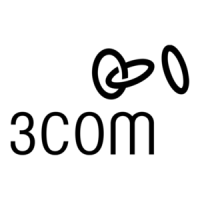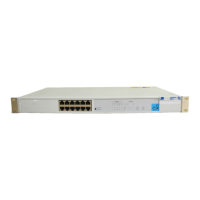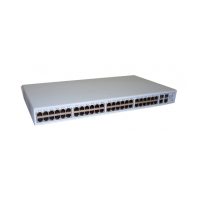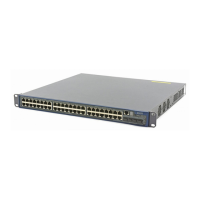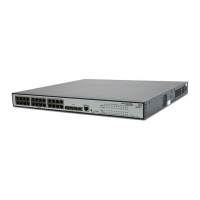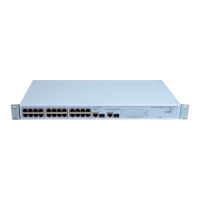Do you have a question about the 3Com PS Hub 40 and is the answer not in the manual?
The PS Hub 40 and PS Hub 50 share many features.
Complete SmartAgent™ management which is built into each hub.
The segment switch is an additional part of the PS Hub 50 which links the stack’s four cascaded segments.
Figure 3-1 shows the hub’s diagnostic LEDs and easy to use ports.
This section describes how to connect workstations to the hub using the 10BASE-T RJ45 ports.
You can increase the number of ports in your network by connecting additional PS Hub 40 and PS Hub 50 units.
The PS Hub has a very useful feature called load balancing.
The load balancing feature monitors the traffic levels in the stack.
With management, you can change and view the way the stack or network operates.
A stack of PS Hubs is treated as a single manageable entity, and the management is distributed.
The PS Hub’s Command Line Interface (CLI) is a simple text-based user interface.
When managing your stack over the network, you must remember that (regardless of your method of management).
If you are uncertain about what IP addresses to assign your equipment, contact your network administrator.
The CLI allows you to configure a limited set of parameters for the hub.
You can manage the PS Hub using its web interface.
You can manage the PS Hub using Quick Config Manager.
By default, the hub automatically configures the baud rate of its console port.
Table 6-1 shows the default users that can access the hub and their level of access.
We recommend that setting a password is the first task you carry out on the hub.
Before you can manage the hub over the network, you must assign it an IP address and subnet mask.
Resetting the stack simulates powering off and powering on the stack.
Initializing the stack causes it to return to its factory default settings.
You can access the web interface for the stack either through the console port or over the network.
This page specifies a unique IP address for the stack.
This page specifies the port state (enable or disable), link state, partition state.
This page is used to initialize the stack.
This page is used to initiate the load balancing feature in the stack.
This page is used to reset the stack.
This page is used to upgrade the management software on the hubs in the stack.
A good way of isolating a problem is to see whether it occurs on a particular port only.
Check your power cord connection. If the connection is secure and there is still no power.
The initial Login prompt does not display. Check that your terminal or terminal emulator is correctly configured.
The web browser cannot access the stack. Check that the stack’s IP address, subnet mask and default router are correctly configured.
The SNMP network management application cannot access the stack. Check that the stack’s IP address, subnet mask and default router are correctly configured.
This section shows the pin-outs for the various cables that are used with the PS Hub.
This section has information on what you need to install Quick Config Manager.
Windows ‘95 and Windows NT allow you to manage the stack over the network using Quick Config Manager.
The PS Hub uses community strings as a security measure, to check management access to the stack.
You can configure the stack with an IP address and other address information.
You can use Quick Config Manager to set up the segments within the stack to create workgroups.
The PS Hub has a load balancing feature which you can use to move the ports between the segments.
You can fix segments and ports so that they are not moved by load balancing.
You can control many areas of the load balancing feature, including invoking the feature manually.
To enable or disable the automatic load balancing feature:
In the future, an upgrade may be issued which enhances the functionality of the PS Hub.
You cannot access the hub over a serial connection for the first time.
The serial web utility can be installed on to a management station that already has other Transcend management applications installed on it.
Every time you want to access the web interface through a serial link, make your management connection.
If you are unable to connect to the hub’s web interface, it may be that the hub is not turned on.
If you have any problems using the upgrade utility, use the following actions to solve your problems.
The PS Hub 40 and PS Hub 50 share many features.
Complete SmartAgent™ management which is built into each hub.
The segment switch is an additional part of the PS Hub 50 which links the stack’s four cascaded segments.
Figure 3-1 shows the hub’s diagnostic LEDs and easy to use ports.
This section describes how to connect workstations to the hub using the 10BASE-T RJ45 ports.
You can increase the number of ports in your network by connecting additional PS Hub 40 and PS Hub 50 units.
The PS Hub has a very useful feature called load balancing.
The load balancing feature monitors the traffic levels in the stack.
With management, you can change and view the way the stack or network operates.
A stack of PS Hubs is treated as a single manageable entity, and the management is distributed.
The PS Hub’s Command Line Interface (CLI) is a simple text-based user interface.
When managing your stack over the network, you must remember that (regardless of your method of management).
If you are uncertain about what IP addresses to assign your equipment, contact your network administrator.
The CLI allows you to configure a limited set of parameters for the hub.
You can manage the PS Hub using its web interface.
You can manage the PS Hub using Quick Config Manager.
By default, the hub automatically configures the baud rate of its console port.
Table 6-1 shows the default users that can access the hub and their level of access.
We recommend that setting a password is the first task you carry out on the hub.
Before you can manage the hub over the network, you must assign it an IP address and subnet mask.
Resetting the stack simulates powering off and powering on the stack.
Initializing the stack causes it to return to its factory default settings.
You can access the web interface for the stack either through the console port or over the network.
This page specifies a unique IP address for the stack.
This page specifies the port state (enable or disable), link state, partition state.
This page is used to initialize the stack.
This page is used to initiate the load balancing feature in the stack.
This page is used to reset the stack.
This page is used to upgrade the management software on the hubs in the stack.
A good way of isolating a problem is to see whether it occurs on a particular port only.
Check your power cord connection. If the connection is secure and there is still no power.
The initial Login prompt does not display. Check that your terminal or terminal emulator is correctly configured.
The web browser cannot access the stack. Check that the stack’s IP address, subnet mask and default router are correctly configured.
The SNMP network management application cannot access the stack. Check that the stack’s IP address, subnet mask and default router are correctly configured.
This section shows the pin-outs for the various cables that are used with the PS Hub.
This section has information on what you need to install Quick Config Manager.
Windows ‘95 and Windows NT allow you to manage the stack over the network using Quick Config Manager.
The PS Hub uses community strings as a security measure, to check management access to the stack.
You can configure the stack with an IP address and other address information.
You can use Quick Config Manager to set up the segments within the stack to create workgroups.
The PS Hub has a load balancing feature which you can use to move the ports between the segments.
You can fix segments and ports so that they are not moved by load balancing.
You can control many areas of the load balancing feature, including invoking the feature manually.
To enable or disable the automatic load balancing feature:
In the future, an upgrade may be issued which enhances the functionality of the PS Hub.
You cannot access the hub over a serial connection for the first time.
The serial web utility can be installed on to a management station that already has other Transcend management applications installed on it.
Every time you want to access the web interface through a serial link, make your management connection.
If you are unable to connect to the hub’s web interface, it may be that the hub is not turned on.
If you have any problems using the upgrade utility, use the following actions to solve your problems.
| Data Transfer Rate | 10 Mbps |
|---|---|
| Form Factor | Desktop |
| Compatibility | IEEE 802.3 |
| Power Supply | External power adapter |
| Type | Ethernet Hub |
